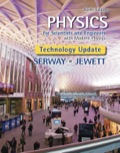
Concept explainers
(a)
The smallest outside radius permitted for a bend in the fiber.
(a)
Answer to Problem 49P
The smallest outside radius permitted for a bend in the fiber is
Explanation of Solution
The ray diagram for the optical fiber is shown in figure below.

Figure (1)
It is given that,
Here,
Write the expression to calculate the critical angle.
Here,
Re arrange equation (I) to get the expression for
Consider figure (1).
Since the light ray on the left side of point
From figure (1).
Substitute
Here,
Also,
Since,
Consider
Substitute
The condition for total internal reflection to occur is,
Substitute
Conclusion:
Substitute
So the smallest outside radius for no light to escape is,
Therefore, the smallest outside radius permitted for a bend in the fiber is
(b).
The effect on the smallest outer radius when
(b).
Answer to Problem 49P
The effect on the smallest outer radius when
Explanation of Solution
Rearrange the expression for
From equation (IX), it is clearly visible that
So, as
Yes, this behavior is reasonable because for very small diameter, the light strikes the interface at very large angles of incidence.
(c).
The effect on the smallest outer radius when
(c).
Answer to Problem 49P
The value of smallest outer radius
Explanation of Solution
From equation (IX), when
From equation (I), when
Thus, the above result is reasonable because with the increase in the value of
(d).
The effect on the smallest outer radius when
(d).
Answer to Problem 49P
The value of smallest outer radius
Explanation of Solution
From equation (IX), when
From equation (I), when
This result is reasonable because the critical angle becomes close to
(e).
The value of
(e).
Answer to Problem 49P
The value of
Explanation of Solution
Conclusion:
Substitute
Therefore, the value of
Want to see more full solutions like this?
Chapter 35 Solutions
Physics for Scientists and Engineers with Modern Physics Technology Update
 Principles of Physics: A Calculus-Based TextPhysicsISBN:9781133104261Author:Raymond A. Serway, John W. JewettPublisher:Cengage Learning
Principles of Physics: A Calculus-Based TextPhysicsISBN:9781133104261Author:Raymond A. Serway, John W. JewettPublisher:Cengage Learning Physics for Scientists and Engineers: Foundations...PhysicsISBN:9781133939146Author:Katz, Debora M.Publisher:Cengage Learning
Physics for Scientists and Engineers: Foundations...PhysicsISBN:9781133939146Author:Katz, Debora M.Publisher:Cengage Learning Physics for Scientists and Engineers with Modern ...PhysicsISBN:9781337553292Author:Raymond A. Serway, John W. JewettPublisher:Cengage Learning
Physics for Scientists and Engineers with Modern ...PhysicsISBN:9781337553292Author:Raymond A. Serway, John W. JewettPublisher:Cengage Learning Physics for Scientists and EngineersPhysicsISBN:9781337553278Author:Raymond A. Serway, John W. JewettPublisher:Cengage Learning
Physics for Scientists and EngineersPhysicsISBN:9781337553278Author:Raymond A. Serway, John W. JewettPublisher:Cengage Learning Physics for Scientists and Engineers, Technology ...PhysicsISBN:9781305116399Author:Raymond A. Serway, John W. JewettPublisher:Cengage Learning
Physics for Scientists and Engineers, Technology ...PhysicsISBN:9781305116399Author:Raymond A. Serway, John W. JewettPublisher:Cengage Learning




